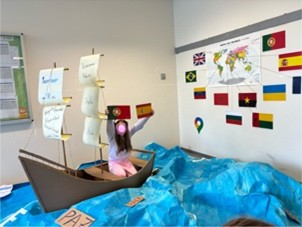Palavrândia: An Intercultural STEAM Journey with Linguistic Biographies
Institution
Agrupamento de Escolas Miguel Torga
Institution Typology
School
Country
Portugal
Stakeholders involved
Primary Students
Teachers
Families and the local community
Partner country from the border
Summary
The practice "Palavrândia" consisted of an interdisciplinary approach that integrated the areas of Languages, Mathematics, Science, Arts, Technology and Engineering, based on the STEAM methodology and the enhancement of interculturality. The activity began with the creation of the linguistic biographies of the students, from which an imaginary country was built — the Palavrândia. The practice involved data analysis, the use of digital tools such as Google Earth and Maps, the construction of symbolic border houses and culminated in an artistic exhibition with an intercultural boat decorated with words from different languages. The practice promoted critical thinking, artistic expression, and the pedagogical use of technology in humanities teaching.
CONTEXT AND OBJECTIVES
Problem addressed or learning needs
The practice responded to the need to make the learning of the humanities more meaningful, interactive and connected to the reality of the students. The use of computational thinking through tools such as Google Maps and Earth allowed us to work on:
- Spatial and geographical notions
- Organization and interpretation of linguistic data
- Symbolic and narrative representation
- Valuing linguistic diversity
- Work collaboratively with a school in another country, requiring intercultural communication and shared curriculum management.
The educational goals pursued were:
- Cognitive: Understanding of linguistic, geographic and cultural data; Mathematical concepts applied to reality
- Metacognitives: Reflection on identity, languages and diversity
- Collaborative: Group work between students from the same school and between countries
- Creative: Production of artistic materials and digital narratives
Types of enhanced competences
- Computational and digital thinking
- Cultural and linguistic literacy
- Collaboration and teamwork
- Art and visual education
- Logical reasoning and data analysis
- Citizenship and Development
METHODS, STRATEGIES AND TOOLS
Subjects involved
Humanities, Technologies\Engineering, Math, Civic education, Foreign Languages, Arts
Duration and timeline of implementation
The project was developed over a term, with weekly activities (about 1 to 2 hours per subject involved) and occasional moments of international collaboration in an online format.
Strategies and activities
- Languages: Creation of linguistic biographies
- Mathematics: Analysis of data on linguistic biographies of the school, itineraries and coordinates, measures of length
- Technology/Geography: Distance measurement and school location with Google Maps and Earth
- Arts/Engineering: Construction of the border houses and the intercultural boat
- Civic Education/Human Sciences: Reflection on identity, cultural diversity and rules of coexistence
- Public presentation: Final exhibition open to the community
Material Sources
- Computers, tablets, projectors
- Google Earth, Google Maps, text and image editors (e.g. Canva, PowerPoint, Genialy, Padlet, Wix website), video and sound editing tools and Zoom Meeting, Scratch, Bee-Bot robots...)
Methodology
Team Work, Cooperative Learning, Storytelling, Learning By Doing, Inquiry-Based Learning, Digital Storytelling, Technology-Enhanced Active Learning (Teal), Debate
IMPACT AND RESULTS
Impact
n. of schools involved – 2 (Portugal e Espanha)
Observed Benefits
- Increased student engagement and motivation
- Strengthening cultural identity and valuing diversity
- Development of digital and collaborative skills
- Emotional and artistic education
- Bringing school and community closer together
- Promotion of global awareness and intercultural dialogue
Challenges Faced
- Pedagogical coordination between two schools from different countries
- Need to find common points of convergence in the curricula of the two countries
- Adapting to working in online environments
- Logistics and implementation time
- Unequal access to technological tools by the students.
LESSONS LEARNT AND RECOMMENDATIONS
Key Success Factors
- Interdisciplinary engagement and the use of active methodologies
- Affective participation of students in their linguistic histories
- Support from the school community
- Integration of accessible and creative technologies
Future Improvements
- Expand the interactivity of the final exhibition, through the integration of digital resources such as QR codes with students' audios, explanatory videos or multimedia presentations. This approach would make the experience more immersive, accessible and attractive to different audiences, in addition to facilitating the dissemination of the project to other classes, schools and educational communities, even at a distance.
- Create a shared digital platform with the partner school, allowing the continuity of intercultural dialogue, the exchange of materials and the sharing of work in real time. This tool can also serve as a digital portfolio for students.
- Deepen the curricular articulation between schools in different countries, planning joint activities, with shared learning objectives.
- Expand and integrate intercultural experiences at all levels of education, promoting contact with linguistic and cultural diversity from an early age, and ensuring the continuity of these practices throughout the school career. This approach contributes to forming students who are more empathetic, globally aware and prepared for multicultural contexts.
Recommendations
- Promote the integration of intercultural practices from the early years of schooling, using active methodologies and creative approaches, contributing to the development of empathy, the appreciation of diversity and the construction of open and conscious identities.
- Encourage international school partnerships, even at primary school levels, to foster intercultural dialogue and the sharing of experiences between students from different backgrounds. Linking curricula can be challenging, but also a global learning opportunity.
- Use simple and accessible digital tools (such as Google Earth, Maps or Canva) to work on digital skills related to the humanities, promoting spatial thinking, logical reasoning and a sense of global belonging.
- Incorporate artistic and manual dimensions in educational projects, such as the construction of the intercultural boat, as these allow for students' emotional expression, practical collaboration and community involvement.
- Involve the school and family community in the teaching-learning processes, creating moments of sharing (such as exhibitions) that reinforce the ties between school and territory, and value learning as a social and collective process.

